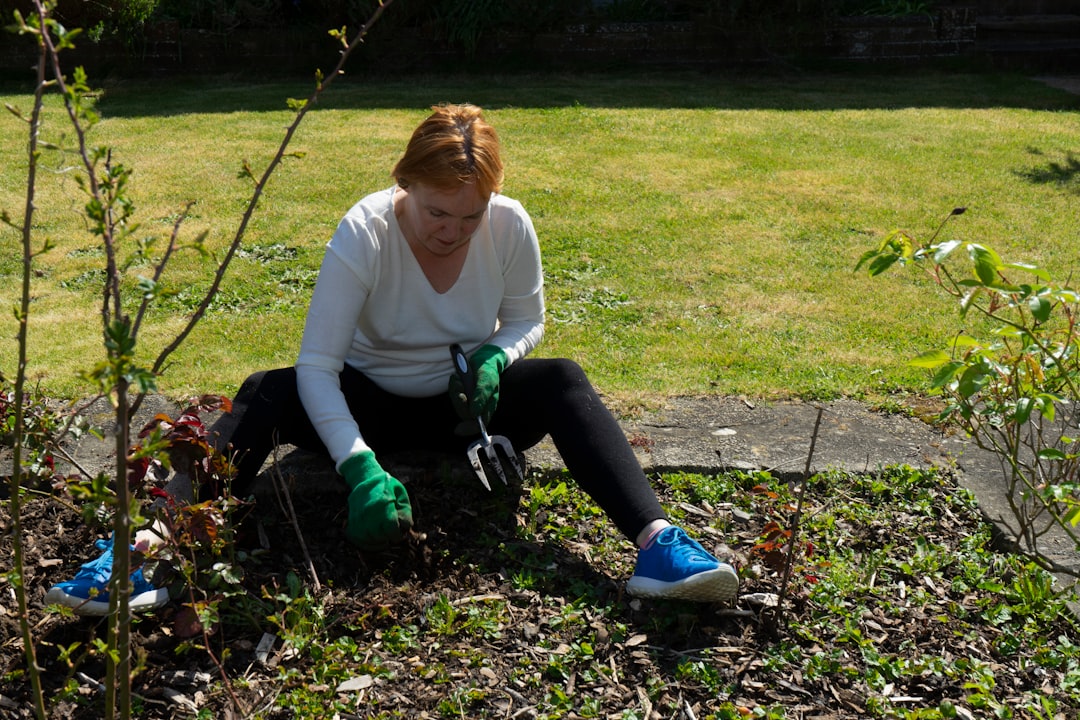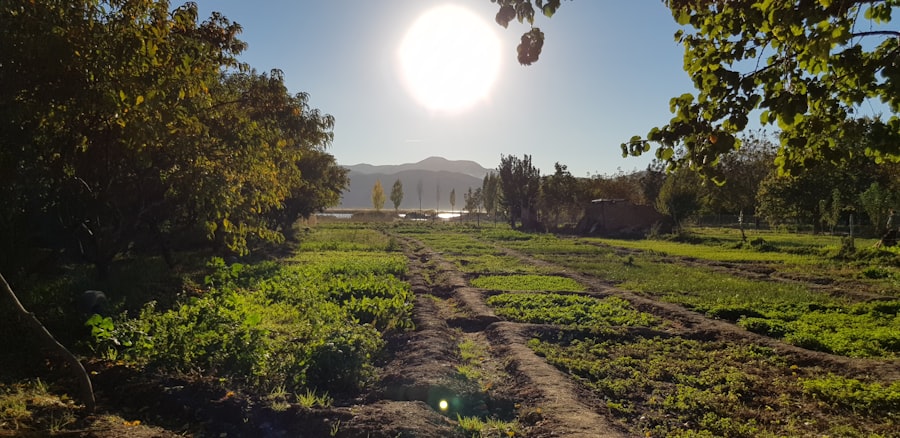Leveling Your Lawn: How to Fill Low Spots

Having a level lawn is not only aesthetically pleasing, but it also has several benefits. A level lawn provides a smooth and even surface for activities such as playing sports, hosting outdoor events, or simply enjoying a walk. It also helps with proper water drainage, preventing water from pooling in certain areas and causing damage to the grass. Additionally, a level lawn makes mowing and maintenance easier, ensuring that the grass is cut evenly and at the desired height. Overall, leveling your lawn is an important step in creating a beautiful and functional outdoor space.
Key Takeaways
- Low spots in your lawn can cause water pooling and uneven mowing.
- Tools needed for leveling your lawn include a shovel, rake, and wheelbarrow.
- To identify low spots, look for areas where water pools or grass grows poorly.
- Steps for filling low spots include removing excess grass, adding soil, and compacting the area.
- Topsoil, sand, and compost can all be used to level your lawn.
Causes of low spots in your lawn
There are several factors that can contribute to the formation of low spots in your lawn. One common cause is the natural settling of soil over time. As the soil compacts, it can create depressions or low areas in the lawn. Poor drainage is another factor that can lead to low spots. When water does not drain properly, it can accumulate in certain areas and cause the soil to erode or sink. Heavy foot traffic is also a common cause of low spots, especially in areas where people frequently walk or play. The constant pressure on the grass can cause it to wear down and create depressions. Lastly, animal activity such as digging or burrowing can also result in low spots in your lawn.
Tools and materials needed for leveling your lawn
Before you begin leveling your lawn, it’s important to gather the necessary tools and materials. Some of the essential tools include a shovel for removing debris and digging, a garden rake for spreading materials evenly, and a wheelbarrow for transporting soil or compost. In terms of materials, you will need topsoil to fill in the low spots and create an even surface. Sand can also be used to level the lawn, as it helps with drainage and provides stability. Additionally, compost can be used to improve the overall health of the soil and promote grass growth.
How to identify low spots in your lawn
| Low Spot Indicators | Possible Causes | Solutions |
|---|---|---|
| Pooling water after rain | Compacted soil, poor drainage | Aerate soil, add organic matter, improve drainage |
| Uneven grass height | Soil erosion, animal activity | Reseed bare spots, add topsoil, install edging |
| Bare patches | Heavy foot traffic, disease, pests | Reseed or sod, treat for pests or disease, limit foot traffic |
Before you can start filling in the low spots, you need to identify where they are located. One way to do this is through visual inspection. Walk around your lawn and look for areas that appear sunken or uneven. These areas may be lower than the surrounding grass and can often be seen by the naked eye. Another method is to use a level. Place the level on different areas of your lawn and see if it indicates any unevenness. If one end of the level is higher than the other, it means that there is a low spot in that area. Lastly, you can use a string line to identify low spots. Tie a string tightly between two stakes and place it across your lawn. If the string sags or dips in certain areas, it indicates a low spot.
Steps for filling low spots in your lawn
Once you have identified the low spots in your lawn, it’s time to start filling them in. The first step is to remove any debris or grass from the low spot. Use a shovel to clear away any rocks, sticks, or other objects that may be present. Next, add topsoil, sand, or compost to the low spot. Start with a small amount and gradually add more until the low spot is filled. Use a garden rake to spread the material evenly and ensure that it is level with the surrounding grass. Finally, tamp down the material with a flat object such as a piece of wood or the back of a shovel. This will help compact the soil and create a stable surface.
Using topsoil to level your lawn

Using topsoil is a common method for leveling lawns as it provides nutrients for grass growth and helps improve soil quality. When applying topsoil to low spots, start by removing any debris or grass from the area. Then, add a layer of topsoil to the low spot, making sure to spread it evenly with a garden rake. The amount of topsoil needed will depend on the depth of the low spot. It’s important to add enough topsoil to fill the low spot and create a level surface. Once the topsoil is spread, tamp it down with a flat object to compact the soil and create a stable base for the grass.
Using sand to level your lawn
Sand can also be used to level your lawn, especially in areas where drainage is a concern. Sand helps improve water flow and prevents water from pooling in certain areas. To use sand for leveling, start by removing any debris or grass from the low spot. Then, add a layer of sand to the low spot and spread it evenly with a garden rake. The amount of sand needed will depend on the depth of the low spot. It’s important to add enough sand to fill the low spot and create a level surface. Once the sand is spread, tamp it down with a flat object to compact it and create a stable base for the grass.
Using compost to level your lawn
Compost is another option for leveling your lawn, and it offers additional benefits for soil health and grass growth. Compost is rich in organic matter and nutrients, which can help improve soil structure and fertility. To use compost for leveling, start by removing any debris or grass from the low spot. Then, add a layer of compost to the low spot and spread it evenly with a garden rake. The amount of compost needed will depend on the depth of the low spot. It’s important to add enough compost to fill the low spot and create a level surface. Once the compost is spread, tamp it down with a flat object to compact it and create a stable base for the grass.
Tips for maintaining a level lawn
Once you have leveled your lawn, it’s important to take steps to maintain its even surface. Regular mowing is essential for preventing the grass from growing unevenly and creating new low spots. Set your mower at the appropriate height for your grass type and make sure to mow regularly to keep the grass at a consistent length. Proper watering is also important for maintaining a level lawn. Water deeply and infrequently to encourage deep root growth and prevent water from pooling in certain areas. Aeration is another key maintenance practice for a level lawn. Aerating the soil helps improve drainage and prevents compaction, which can lead to low spots. Lastly, fertilization is important for promoting healthy grass growth and preventing bare spots. Use a balanced fertilizer according to the recommended application rates for your specific grass type.
Conclusion and final thoughts on leveling your lawn
In conclusion, leveling your lawn is an important step in creating a beautiful and functional outdoor space. It provides a smooth and even surface for activities, improves water drainage, and makes maintenance easier. By identifying low spots in your lawn and filling them with topsoil, sand, or compost, you can achieve a level surface that promotes healthy grass growth. Remember to regularly mow, properly water, aerate, and fertilize your lawn to maintain its level surface. With these tips and techniques, you can create a level lawn that you can enjoy for years to come. So don’t hesitate, take action today and start leveling your lawn!
If you’re looking for more information on how to fill low spots in your lawn, be sure to check out this helpful article from Lawn World. They provide expert tips and step-by-step instructions on how to tackle this common issue. Whether you’re dealing with small depressions or larger areas that need attention, this article will guide you through the process of achieving a level and healthy lawn. For more lawn care advice and resources, visit Lawn World’s sitemap at https://www.lawnworld.com/sitemap.html.
FAQs
What causes low spots in a lawn?
Low spots in a lawn can be caused by a variety of factors, including soil erosion, settling, and poor drainage.
Why is it important to fill low spots in a lawn?
Filling low spots in a lawn is important because they can create uneven areas that are difficult to mow and can lead to water pooling, which can damage the grass and create muddy areas.
What materials can be used to fill low spots in a lawn?
Materials that can be used to fill low spots in a lawn include topsoil, sand, compost, and a mixture of these materials.
How do I determine how much material I need to fill a low spot in my lawn?
To determine how much material you need to fill a low spot in your lawn, measure the length, width, and depth of the low spot and calculate the cubic footage. Then, use a soil calculator to determine how much material you need.
What is the best time of year to fill low spots in a lawn?
The best time of year to fill low spots in a lawn is in the spring or fall when the grass is actively growing and the soil is moist.
How do I fill a low spot in my lawn?
To fill a low spot in your lawn, remove any dead grass or debris from the area, add the filling material, and level it out with a rake or shovel. Then, water the area thoroughly to help the material settle and encourage grass growth.



